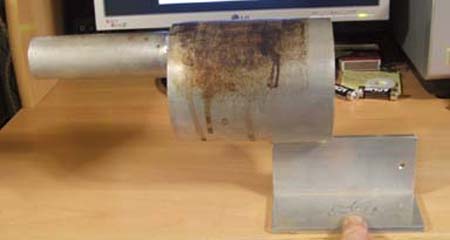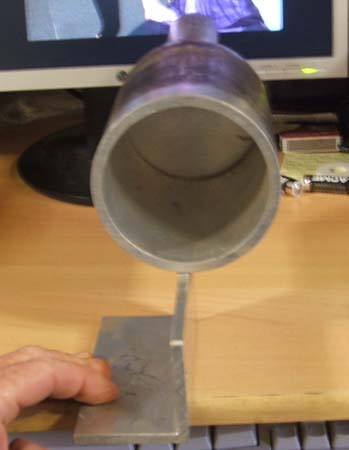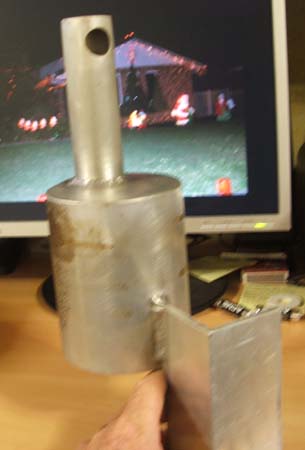Hi guys now the problem I'm having is in bending Makore (Brazillian cherry, I thicknessed it to 85 thou (2.2mm) as I've done previously for rosewood and mahogany, they both bent easily, the rosewood was so so easy, this is a real pain, I've got one side done, and it really needed soaking and keeping it nearly saturated all the time to make it move, and now the second side is still putting up a fight I usually bend over a 2" stainless hot pipe.
Also I recently struggled bending maple binding for a uke, until I soaked it overnight and just persuaded it into the channels then taped it left it overnight and just touched up the spring back on the iron.
Any clues or tips should I build a fox bender I have the bulb fittings to hand, and some 22 swg mild steel I know I'd need to straighten it after use though.
Bending Problems
I do find the Fox style bender to be so much better at getting sides bent without drama. Your dimensions seem about right, so it might just be that this wood is particularly tough to bend. Maple has always bent very easy for me, and bindings shouldn't take anything special to get them to move. Don't know what the issue could be there.
My first bender used the light bulbs and while it worked, it was a much slower process than with a heating blanket. One thing to keep in mind with the light bulb method, is to have enough metal slats in the form to act as a sufficient heat sink to even out the temperature, and to keep it up while bending. I also found that I need to heat mine up for about 20 minutes before putting the slats and wood on the bender. I used a spritz bottle of water to test that things were hot enough before starting. If the water sizzles and bounces off, then its hot enough. If not, then wait longer.
My first bender used the light bulbs and while it worked, it was a much slower process than with a heating blanket. One thing to keep in mind with the light bulb method, is to have enough metal slats in the form to act as a sufficient heat sink to even out the temperature, and to keep it up while bending. I also found that I need to heat mine up for about 20 minutes before putting the slats and wood on the bender. I used a spritz bottle of water to test that things were hot enough before starting. If the water sizzles and bounces off, then its hot enough. If not, then wait longer.
- Nick
- Blackwood
- Posts: 3628
- Joined: Thu Feb 26, 2009 11:20 am
- Location: Christchurch, New Zealand
- Contact:
I use a bending iron & 'play' around with wetting/not wetting the individual types of wood (starting from dry and working to wet as required) so I don't know much about Fox style bending but picking up on a point made by Allen. I have seen Micheal Collins ( a canadian luthier that makes Selmer Maccaferri's) use a bulb type side bender and he put a layer of thin aluminium down first which acted as an excellent heat sink to distribute heat off the bulbs evenly along the sides.
Also you say you use a stainless pipe for your bending, try using a mild steel pipe (just clean it up first with some wet & dry). Stainless is notoriously bad for heat conduction and I suspect that unless you are bending directly on the spot that is being heated (by a gas torch I suspect?), that even a little way from that point there will be a difference in temperature enough to cause temperature differences in your wood. It may 'feel' even but if you used a high temperature pyrometer to measure surface temp that there will be a variation of more than a few degrees on the surface I suspect.
Also you say you use a stainless pipe for your bending, try using a mild steel pipe (just clean it up first with some wet & dry). Stainless is notoriously bad for heat conduction and I suspect that unless you are bending directly on the spot that is being heated (by a gas torch I suspect?), that even a little way from that point there will be a difference in temperature enough to cause temperature differences in your wood. It may 'feel' even but if you used a high temperature pyrometer to measure surface temp that there will be a variation of more than a few degrees on the surface I suspect.
"Jesus Loves You."
Nice to hear in church but not in a Mexican prison.
Nice to hear in church but not in a Mexican prison.
If you want to keep a pipe bender make it aluminium or steel . The heat goes straight through S/S and it doesn't become a heat sink. As soon as you put your wet timber on there you suck the heat out of the hottest spot . As for side benders my experience with light bulbs was of not enough heat making it hard to do nicely. Waiting on a bending blanket now from MEI.






Cheers from Micheal.
Remember the "5P Rule".
Preparation Prevents Piss Poor Performance.
Remember the "5P Rule".
Preparation Prevents Piss Poor Performance.
- rocket
- Blackwood
- Posts: 1210
- Joined: Thu Apr 30, 2009 8:43 pm
- Location: melbourne,, outer east
- Contact:
fox bender
hi people can you describe to me what a fox bender is thanks.
I think the problem with the bindings and correct me if I'm wrong, is that the grain didn't run straight up and down the length, there were several areas where it went diagonally across the width of the binding, and this is where it wanted to snap.
And this may just be a tough but of wood, all experiance gained is good next time I use this wood I know to use more water, and possibly take it thinner I was warned when I bought it that it had a lot of silica in it and that it'd blunt tools quicker.
And this may just be a tough but of wood, all experiance gained is good next time I use this wood I know to use more water, and possibly take it thinner I was warned when I bought it that it had a lot of silica in it and that it'd blunt tools quicker.
Charles Fox is credited with coming up with a design for bending sides for guitars in an apparatus that has been widely copied, and improved on in various ways. David Hurd who is a member of our forum has a page describing his variation and use of the Fox Style Bender.rocket wrote:hi people can you describe to me what a fox bender is thanks.
There are many different designs and ways of using them, and each has its merits and possible drawbacks. Now that you know what one looks like, it's sure to give you some ideas on different possibilities on their use.
My first bender was modeled on David's ( much before I got to meet and get to know him a few months back in Albany). I used 150 watt light bulbs in that one, and while it worked, I did find that some problems arose with getting guitar sized material to bend as well as I wanted. I changed to a heat blanket supplied by MEI, and am much happier with the results I'm getting.
Who is online
Users browsing this forum: No registered users and 194 guests